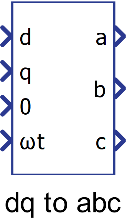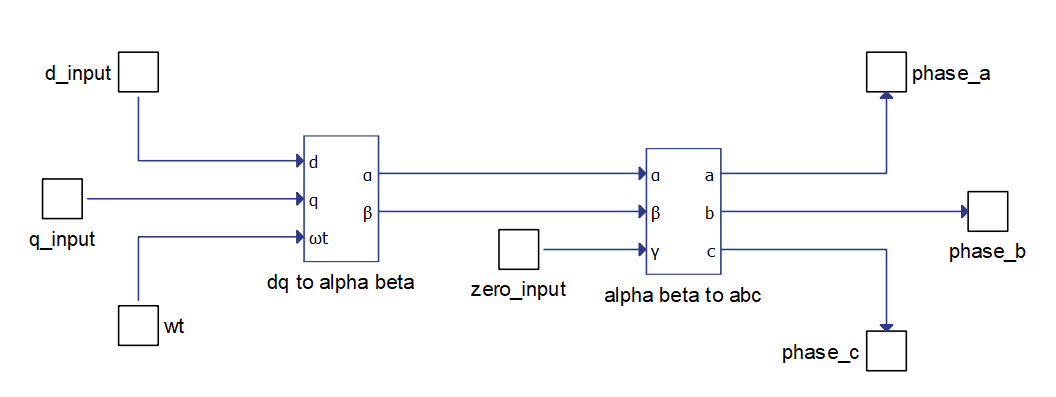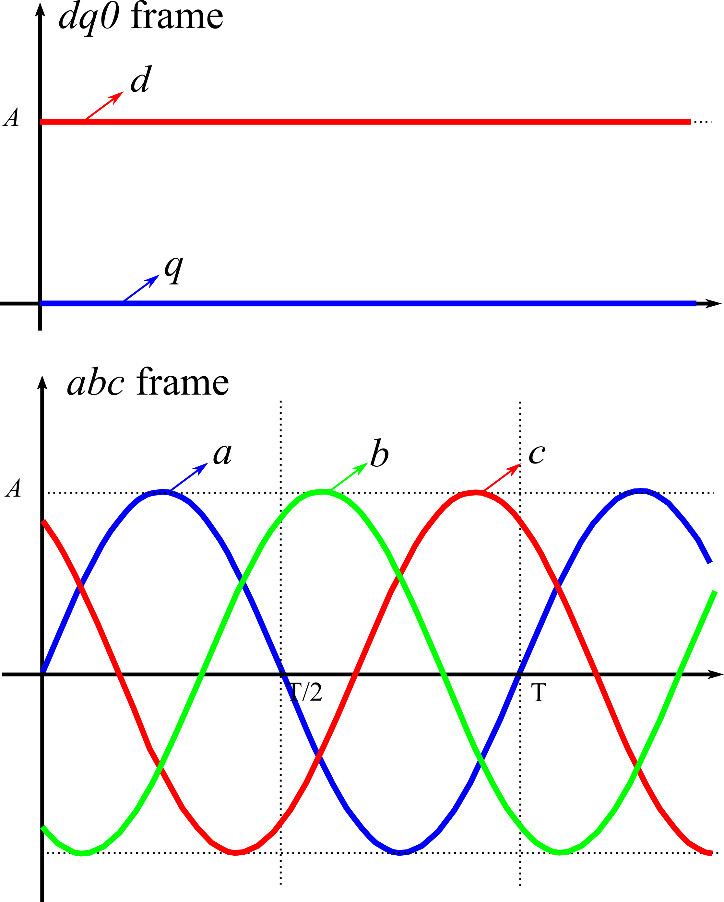DQ to ABC
Description of the DQ to ABC component in Schematic Editor, which performs a DQ to ABC transformation.

Description

The component itself is composite and it is composed of αβ to ABC and DQ to αβ as in Figure 2.
The inputs to this component are the d, q and 0 signals, and the angle ωt. The input 0 is equal to the γ signal to be used in the αβγ to ABC transformation. The outputs are the three-phase quantities.
Figure 2 illustrates the transformation of a DQ0 system to a three phase ABC frame.

Ports
- d (in)
- Input signal of the component related to the d signal of the dq0
frame.
- Supported types: real.
- Vector support: no.
- Input signal of the component related to the d signal of the dq0
frame.
- q (in)
- Input signal of the component related to the q signal of the dq0
frame.
- Supported types: real.
- Vector support: no.
- Input signal of the component related to the q signal of the dq0
frame.
- 0 (in)
- Input signal of the component related to the q signal of the dq0
frame.
- Supported types: uint, int and real.
- Vector support: no.
- Input signal of the component related to the q signal of the dq0
frame.
- ωt (in)
- Angular position of the dq rotating frame.
- Supported types: real, int, uint.
- Vector support: no.
- Angular position of the dq rotating frame.
- a (out)
- Output a of the component, corresponding to the three-phase abc
system.
- Supported types: real.
- Vector support: no.
- Output a of the component, corresponding to the three-phase abc
system.
- b (out)
- Output b of the component, corresponding to the three-phase abc
system.
- Supported types: real.
- Vector support: no.
- Output b of the component, corresponding to the three-phase abc
system.
- c (out)
- Output c of the component, corresponding to the three-phase abc
system.
- Supported types: real.
- Vector support: no.
- Output c of the component, corresponding to the three-phase abc
system.
Properties
- Power transformation form
-
Allows choosing between the methods to perform the transformation. The methods available are:
-
Variant – Clarke's original: Use this method when you want the resulting three-phase abc frame to be amplitude invariant. That is, the amplitude of the alpha-beta-gamma rotating system will be preserved in the abc frame.
-
Variant – uniform: Use this method when the input alpha-beta-gamma frame signal is a balanced system and you want the resulting three-phase abc frame to be amplitude invariant. That is, the amplitude of the original alpha-beta-gamma frame will be preserved in the abc frame.
-
Invariant: Use this method when you want the resulting three-phase abc frame to be power invariant. That is, the power of the of the alpha-beta-gamma rotating system will be preserved in the abc frame.
-
-
- Rotating frame alignment
- Defines the alignment of the dq signals (-π/2 = “q”, 0 = “d”).
- Execution rate
- Type in the desired signal processing execution rate. This value must be compatible with other signal processing components of the same circuit: the value must be a multiple of the fastest execution rate in the circuit. There can be up to four different execution rates. To specify the execution rate, you can use either decimal (e.g. 0.001) or exponential values (e.g. 1e-3) in seconds. Alternatively, you can type in ‘inherit’ in which case the component will be assigned execution rate based on the execution rate of the components it is receiving input from.